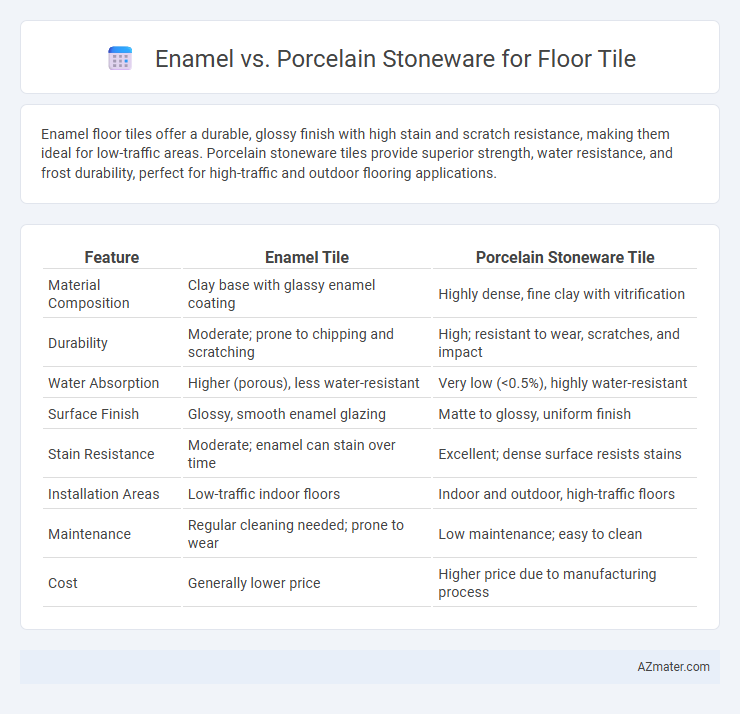Enamel floor tiles offer a durable, glossy finish with high stain and scratch resistance, making them ideal for low-traffic areas. Porcelain stoneware tiles provide superior strength, water resistance, and frost durability, perfect for high-traffic and outdoor flooring applications.
Table of Comparison
| Feature | Enamel Tile | Porcelain Stoneware Tile |
|---|---|---|
| Material Composition | Clay base with glassy enamel coating | Highly dense, fine clay with vitrification |
| Durability | Moderate; prone to chipping and scratching | High; resistant to wear, scratches, and impact |
| Water Absorption | Higher (porous), less water-resistant | Very low (<0.5%), highly water-resistant |
| Surface Finish | Glossy, smooth enamel glazing | Matte to glossy, uniform finish |
| Stain Resistance | Moderate; enamel can stain over time | Excellent; dense surface resists stains |
| Installation Areas | Low-traffic indoor floors | Indoor and outdoor, high-traffic floors |
| Maintenance | Regular cleaning needed; prone to wear | Low maintenance; easy to clean |
| Cost | Generally lower price | Higher price due to manufacturing process |
Introduction to Enamel and Porcelain Stoneware Tiles
Enamel tiles feature a glass-like coating fused to a ceramic base, providing a smooth, durable surface resistant to stains and scratches, ideal for areas with moderate foot traffic. Porcelain stoneware tiles are denser, less porous, and fired at higher temperatures, offering superior strength and water resistance suited for both indoor and outdoor flooring applications. The key differences between enamel and porcelain stoneware tiles lie in their composition, durability, and application versatility.
Composition and Manufacturing Differences
Enamel floor tiles feature a glassy coating fused onto the tile surface through high-temperature firing, providing a smooth, durable finish resistant to stains and scratches. Porcelain stoneware is made from a dense, fine-grained clay mixture fired at temperatures exceeding 1,200degC, resulting in a highly vitrified, non-porous tile with superior strength and water resistance. The primary manufacturing difference lies in enamel tiles receiving a surface layer post-formation, while porcelain stoneware is homogenous throughout, enhancing its durability and suitability for heavy-traffic flooring.
Durability and Resistance to Wear
Porcelain stoneware offers superior durability and resistance to wear compared to enamel tiles, making it ideal for high-traffic areas. Its dense, vitrified composition enhances scratch resistance, impact strength, and moisture impermeability. Enamel tiles, while aesthetically appealing, tend to chip and wear faster under heavy foot traffic, reducing their longevity in demanding environments.
Water Absorption and Stain Resistance
Porcelain stoneware offers superior water absorption rates, typically below 0.5%, making it highly resistant to moisture infiltration and ideal for wet areas. Enamel floor tiles, while often glazed, tend to have higher water absorption due to their ceramic base, increasing vulnerability to stains and water damage over time. Porcelain's dense, non-porous structure also enhances stain resistance, outperforming enamel tiles in maintaining appearance and durability in high-traffic or damp environments.
Aesthetic Options and Design Versatility
Porcelain stoneware offers a wide range of aesthetic options with its ability to mimic natural materials like wood, stone, and marble, providing high design versatility for modern and traditional interiors. Enamel tiles are prized for their vibrant, glossy finishes and bold color options, making them ideal for artistic patterns and decorative accents. Both materials provide durable surfaces, but porcelain stoneware's varied textures and finishes make it more adaptable for extensive flooring applications.
Installation Process and Practical Considerations
Enamel floor tiles typically require a more meticulous installation process due to their delicate surface, which demands careful handling and specialized grout to prevent damage and discoloration. Porcelain stoneware offers superior durability and easier installation, as its dense composition reduces the risk of chipping and allows for thinner adhesive layers. Practical considerations for porcelain include higher resistance to moisture and stains, making it ideal for high-traffic or wet areas, while enamel tiles excel in aesthetic versatility but require more maintenance over time.
Maintenance and Cleaning Requirements
Enamel floor tiles require regular sealing to prevent staining and are prone to chipping, making maintenance more intensive compared to porcelain stoneware, which boasts higher durability and stain resistance due to its dense, vitrified surface. Porcelain stoneware tiles need only routine sweeping and mopping with mild detergents, offering easier and lower-maintenance cleaning requirements. Their resistance to moisture and abrasive cleaners makes porcelain stoneware the preferable choice for long-term, hassle-free floor tile upkeep.
Cost Comparison and Value for Money
Porcelain stoneware floor tiles generally cost more upfront than enamel tiles, with prices ranging from $5 to $15 per square foot compared to enamel's $3 to $8. Porcelain offers superior durability, water resistance, and low maintenance, delivering greater long-term value despite the higher initial investment. Enamel tiles are budget-friendly but tend to chip and wear faster, increasing replacement and repair expenses over time, which can diminish overall cost-effectiveness.
Ideal Applications for Each Tile Type
Enamel floor tiles are ideal for areas requiring enhanced stain resistance and vibrant color retention, such as kitchens and bathrooms, where moisture and frequent cleaning occur. Porcelain stoneware tiles excel in high-traffic zones like commercial spaces and hallways due to their superior hardness, low porosity, and ability to withstand heavy wear and impact. Choosing enamel tiles suits decorative and light-use environments, whereas porcelain stoneware is preferred for durability and long-term performance in demanding applications.
Choosing the Right Tile for Your Flooring Needs
Enamel tiles offer a glossy finish with vibrant color options, ideal for decorative flooring but may be prone to chipping and wear over time. Porcelain stoneware provides exceptional durability, resistance to moisture, and high hardness ratings, making it suitable for high-traffic or outdoor areas. Selecting the right tile depends on balancing aesthetic preferences with functional requirements such as strength, maintenance, and slip resistance for your specific flooring needs.

Infographic: Enamel vs Porcelain Stoneware for Floor Tile
 azmater.com
azmater.com